Waste from which of the following is an example of nonpoint source pollution?
A) Overflow from a sewage treatment plant
B) Outgassing from a municipal landfill
C) Dumping at a food-processing plant
D) Drainage from an abandoned mine
E) Runoff from agricultural fields
E) Runoff from agriculutral fields
Directions: Select the choice that best fits each statement. The following question(s) refer to the following.
(A) Safe Drinking Water Act
(B) Clean Water Act
(C) Comprehensive Environmental Response Compensation and Liability Act (CERCLA)
(D) Resource Conservation and Recovery Act
(E) Toxic Substances Control Act
Mandates the restoration and maintenance of the chemical, physical, and biological integrity of the nation’s waters
B) Clean Water Act
Directions: Select the choice that best fits each statement. The following question(s) refer to the following.
(A) Safe Drinking Water Act
(B) Clean Water Act
(C) Comprehensive Environmental Response Compensation and Liability Act (CERCLA)
(D) Resource Conservation and Recovery Act
(E) Toxic Substances Control Act
Requires minimum safety standards for community water supplies
A) Safe Drinking Water Act
Which of the following examples includes both a point and a nonpoint source of pollution?
A) A factory smokestack and a sewage overflow
B) Runoff from city streets and pesticides from agricultural fields
C) Waste from animal feedlots and sediment from construction sites
D) Fertilizer from suburban lawns and wastewater from a water treatment plant
D) Fertilizer from suburban lawns and wastewater from a water treatment plant
Is a flammable gas produced by landfills
Carbon dioxide
Carbon monoxide
Methane
Radon
Sulfur dioxide
C) Methane
In the United States, the largest single component of municipal solid waste is
A) glass
B) paper
C) food scraps
D) wood and other construction debris
E) plastic
B) paper
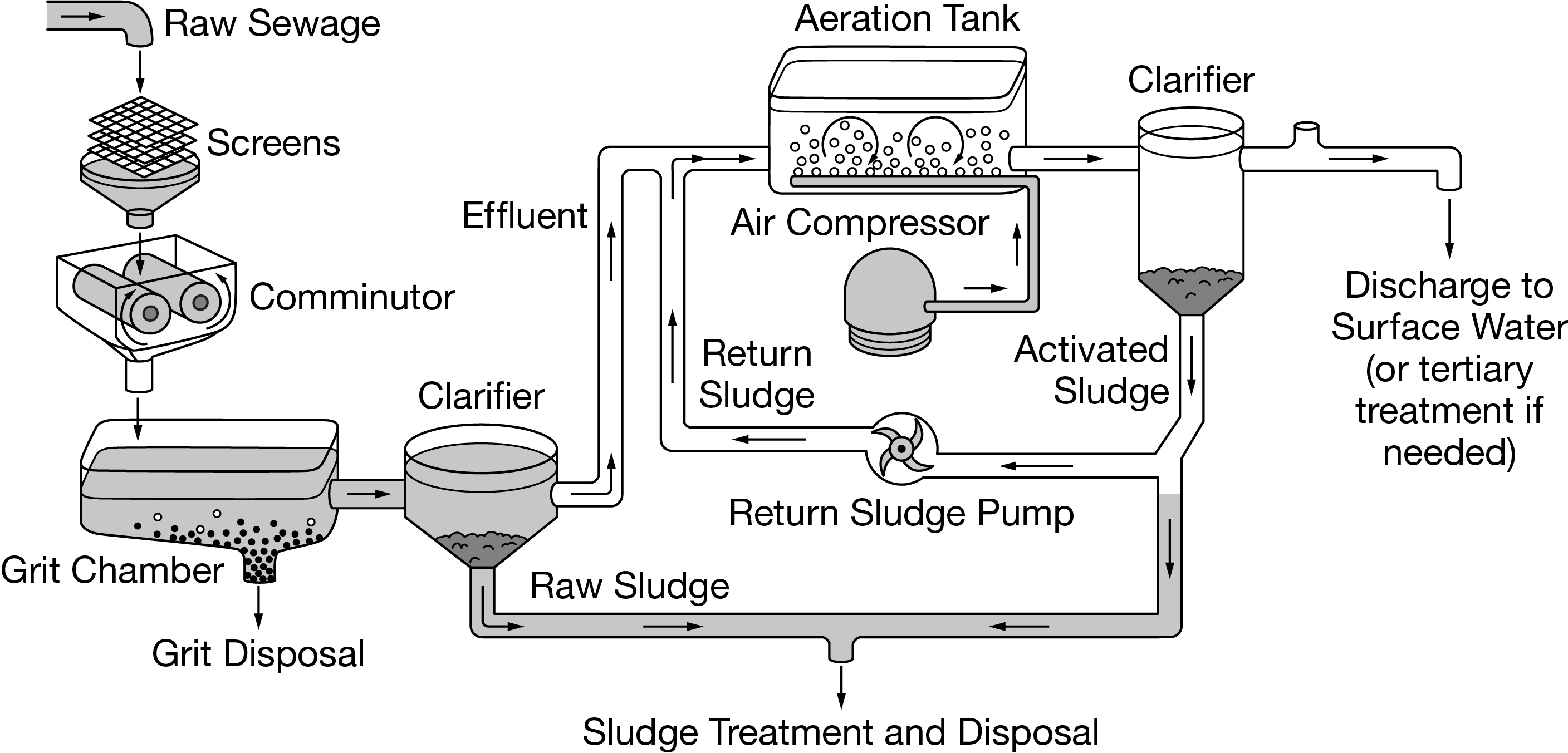 Based on the diagram, which of the following is associated with the primary treatment of sewage?
Based on the diagram, which of the following is associated with the primary treatment of sewage?
A) Grit chamber
B) Aeration tank
C) Effluent
D) Activated sludge
A) Grit Chamber
Large objects, such as sticks and rocks, are screened out and removed during this process.
A) A
B) B
C) C
D) D
A
Of the following strategies to decrease the landfill volume of packaging material from food and other consumer products, the most energy efficient is
A) recovering plastic packaging material from the waste stream and recycling it
B) recovering metal packaging material from the waste stream and recycling it
C) limiting the size of individual beverage containers made from metal, glass, or plastic
D) using more packaging materials that are manufactured from raw materials that are renewable
E) promoting the use of reusable containers for consumer goods
E) promoting the use of reusable containers for consumer goods
Which of the following is true of sewage treatment plants in the United States?
A) They release wastewater before solids are removed from the sewage.
B) They use stormwater runoff to assist in the treatment process.
C) They are not designed to remove pharmaceutical chemicals from wastewater.
D) They have largely eliminated cultural eutrophication in Chesapeake Bay.
E) They release wastewater that is not regulated by the Clean Water Act.
C) They are not designed to remove pharmaceutical chemicals from wastewater
Most municipal solid waste in the United States is disposed of in
A) the oceans
B) sanitary landfills
C) deep wells
D) open dumps
E) abandoned mines
B) sanitary landfills
Which method reduces the volume of waste but could release toxic emissions into the atmosphere?
(A) Sanitary landfill
(B) Incineration
(C) Discharge to sewers, streams, and rivers
(D) Chemical treatment
(E) Biological treatment
B) Incineration
Which method introduces microorganisms to break down hazardous organic compounds?
(A) Sanitary landfill
(B) Incineration
(C) Discharge to sewers, streams, and rivers
(D) Chemical treatment
(E) Biological treatment
E) Biological treatment
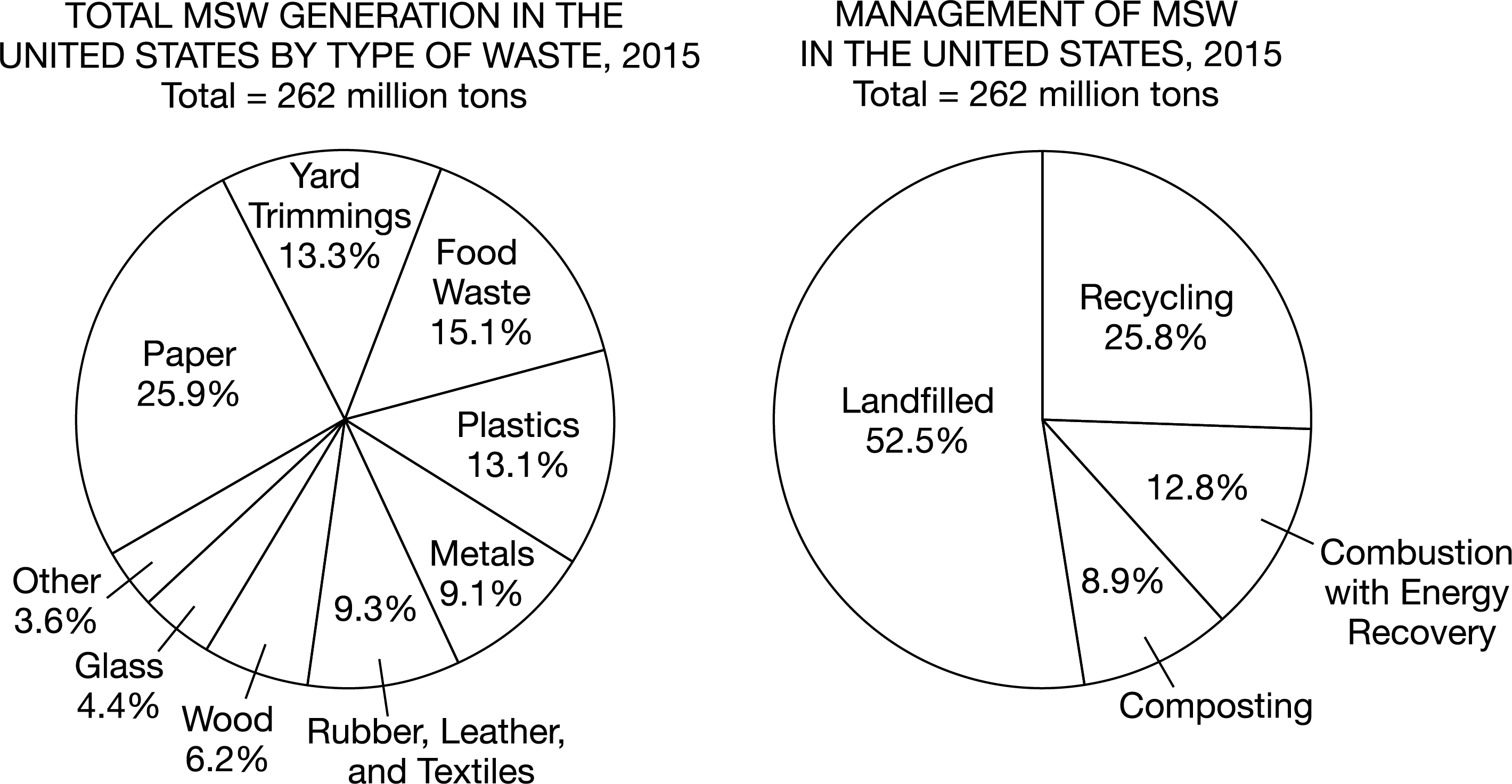 The two pie charts show municipal solid waste () in the United States, 2015.Based on the data in the graphs, which of the following strategies would best increase the total volume of municipal solid waste being recycled?
The two pie charts show municipal solid waste () in the United States, 2015.Based on the data in the graphs, which of the following strategies would best increase the total volume of municipal solid waste being recycled?
A) Free or low-cost pickup of grass trimmings by municipal waste haulers
B) Increased use of plastic packaging for consumer products
C) Enacting a single-stream recycling program and providing bins to residential homes
D) Digitization of news and use of e-mail for communication
C) Enacting a single stream recycling program and providing bins to residential homes
The two pie charts show municipal solid waste () in the United States, 2015. Based on the data in the graphs, which of the following would result in the largest reduction in volume of municipal solid waste disposed of in landfills?
A) Introduce composting programs for yard trimmings and food waste
B) Increase programs to recycle glass and metals
C) Promote reusing plastics and wood products
D) Increase funding to clothing donation programs
A) Introduce composting programs for yard trimmings and food waste
Of the following, which is the most serious immediate problem associated with sanitary landfills?
A) Generation of CO2 gas
B) Leachate contamination of groundwater
C) Release of disease organisms
D) Incomplete degradation of wastes
E) Compaction and settling
B) Leachate contamination of groundwater
The presence of which of the following contaminants would be the strongest reason for judging municipal sewage sludge unfit for use as fertilizer?
A) Human feces
B) Ammonia
C) Phosphates
D) Nitrates
E) Heavy metals
E) Heavy metals
Which of the following describes a component of a modern sanitary landfill?
A) A series of screens and grates to prevent large objects from entering the landfill
B) A bottom liner of plastic or clay to prevent groundwater contamination
C) Aerated tanks in which bacteria break down organic matter
D) Chemical or ultraviolet light systems that kill pathogens
B) A bottom liner of plastic or clay prevent groundwater contamination
Chemical compound that can cause algal blooms and cultural eutrophication in streams
A) Nitrates (NO3-)
B) Chlorofluorocarbons (CFCs)
C) Nitrogen oxides (NOx )
D) Carbon dioxide (CO2)
A) Nitrates
Which of the following is the best description of bioaccumulation?
A) The uptake of essential nutrients by plant roots
B) The absorption of a substance by an organism at a rate greater than the rate of elimination
C) The transfer of persistent pollutants like PCBs from one generation to the next
D) A process that occurs exclusively in marine ecosystems
E) A high mortality rate in organisms that have been exposed to a toxin
B) The absorption of a substance by an organism at a rate greater than the rate of elimination
Some toxic compounds are ingested and retained in the tissues. These pollutants pose special risks to humans and other organisms high on the food chain because of which process?
A) Synergism
B) Compound contamination
C) Biomagnification
D) Threshold effect
E) Carcinogenesis
C) Biomagnification
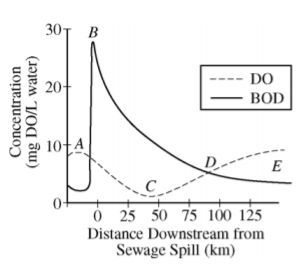 The graph above shows the effect of sewage on biological oxygen demand (BOD) and dissolved oxygen (DO) in a flowing stream. The smallest fish populations will most probably be found at point
The graph above shows the effect of sewage on biological oxygen demand (BOD) and dissolved oxygen (DO) in a flowing stream. The smallest fish populations will most probably be found at point
A) A
B) B
C) C
D) D
E) E
C
Alligators in a Florida lake polluted by high levels of dioxins (chlorinated hydrocarbons) had low testosterone levels and failed to reproduce. Scientists came to the conclusion that the dioxins were acting as which of the following?
A) Endocrine disrupters
B) Growth hormones
C) Carcinogens
D) Immune-system suppressors
E) Mutagens
A) Endocrine disrupters
 The graph below represents the dose response curves of insect pests for four different pesticides. The United States Environmental Protection Agency has determined that all four pesticides could have negative health consequences to humans if applied at high concentrations and has set a maximum application concentration of 500g/cm3. Based on the data in the graph, which pesticide would be the most effective at that concentration?
The graph below represents the dose response curves of insect pests for four different pesticides. The United States Environmental Protection Agency has determined that all four pesticides could have negative health consequences to humans if applied at high concentrations and has set a maximum application concentration of 500g/cm3. Based on the data in the graph, which pesticide would be the most effective at that concentration?
A) A
B) B
C) C
D) D
D
Factors that increase the spread of infectious diseases include all of the following EXCEPT
A) flooding, which contaminates water supplies with raw sewage
B) global warming, which can transfer carriers of disease from tropical to temperate areas
C) introduction of insect vectors, which transmit disease
D) exposure to neurotoxins, which affect the endocrine system
E) rural poverty, which causes people to move into urban areas
D) exposure to neurotoxins, which affect the endocrine system
For a certain insecticide, the LD-50 dosage level for rats is determined to be 250 milligrams per kilograms of body mass. On the basis of this information, which of the following is the best prediction regarding the consequences of receiving this dosage of the insecticide?
A) Fifty percent of any rat population would be sickened.
B) Fifty percent of the population of any warm-blooded animal would die.
C) Fifty percent of any population of mosquitoes would die.
D) Five hundred out of every one thousand people would experience acute effects.
E) Five hundred out of every one thousand rats would die.
E) Five hundred out of every one thousand rats would die.
In a river ecosystem, dissolved oxygen concentrations drop quickly downstream from a point-source input of organic matter into the river. This effect is due to
A) increasing populations of mayfly and stonefly larvae
B) increasing activity of trout and black bass
C) increasing bacterial activity as organic matter decays
D) decreasing bacterial activity as turbidity increases
E) decreasing water temperature as surface evaporation increases
C) increasing bacterial activity as organic matter decays
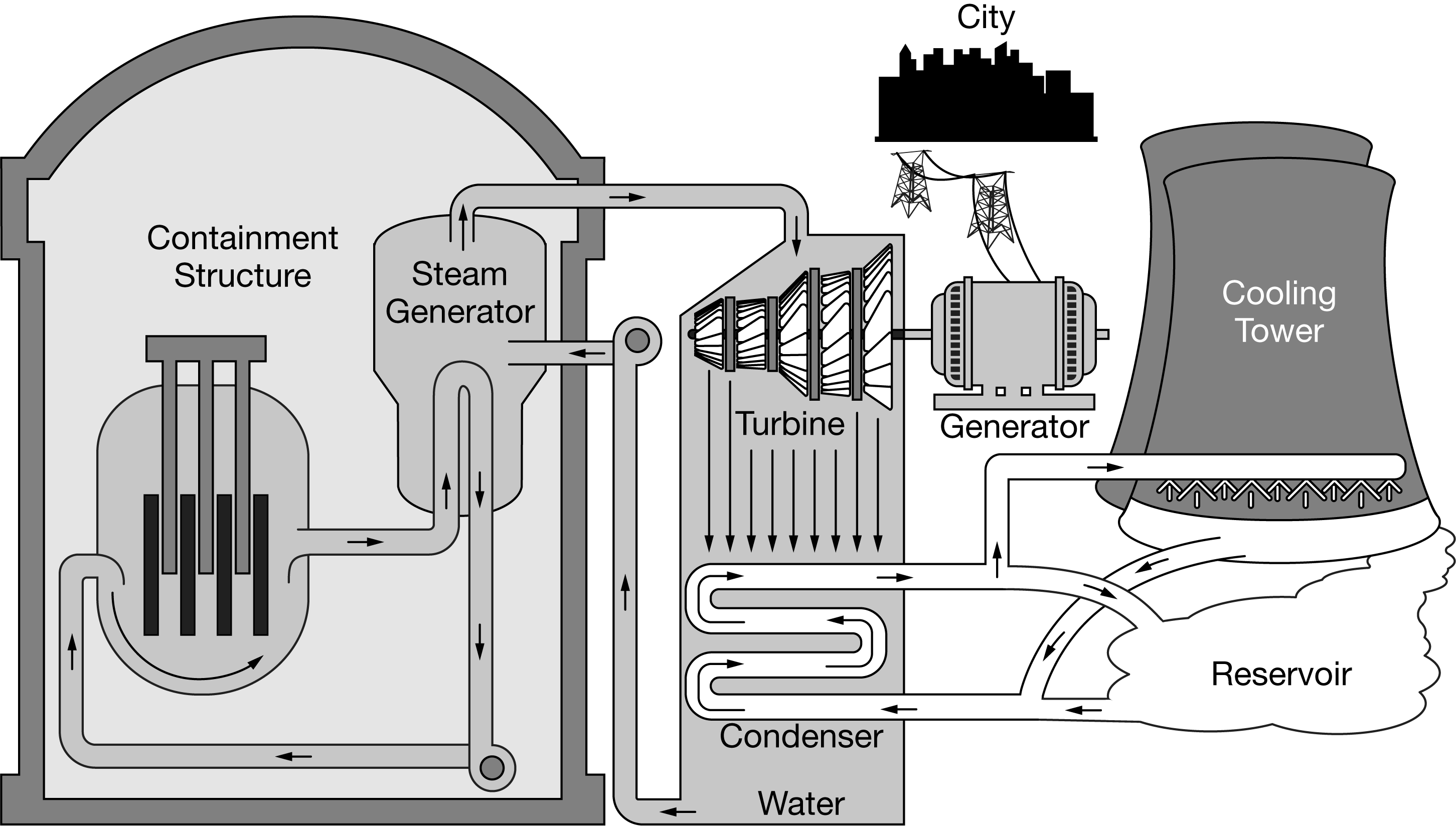 The diagram shows a power plant designed to generate electricity for a nearby city. The water used in this type of power plant is often released back into a reservoir. Which of the following effects could this released water have on the reservoir?
The diagram shows a power plant designed to generate electricity for a nearby city. The water used in this type of power plant is often released back into a reservoir. Which of the following effects could this released water have on the reservoir?
A) The released water is radioactive and is lethal to a variety of organisms in the reservoir.
B) Chemical pollutants in the released water cause algal blooms in the reservoir.
C) Ash from the power plant is dissolved in the released water and will precipitate out into the reservoir.
D) The temperature of the released water causes a decrease in the amount of dissolved oxygen in the reservoir.
D) The temperature of the released water causes a decrease in the amount of dissolved oxygen in the reservoir.
Which of the following best explains why top predators can have up to 60 times as much of persistent organic pollutant () as their prey and up to 600 times as much of the pollutant as producers?
A) accumulate in the body fat of living organisms. increase in concentration as they move up the food chain.
B) can travel over long distances by wind or water. Predators have greater access to different locations than do producers and therefore have higher concentrations of .
C) are not carbon-based compounds, so animal digestive systems lack enzymes capable of breaking them down. biomagnify in the fatty tissues of animals but not in plants.
D) are solids, which only animals can ingest. Therefore, have a greater effect on secondary and tertiary levels of food chains.
A) accumulate in the body fat of living organisms. increase in concentration as they move up the food chain.
 The graphs below show inputs of several different pollutants into the Chesapeake Bay from four major river systems. Which of the following strategies will best reduce eutrophication in the Chesapeake Bay?
The graphs below show inputs of several different pollutants into the Chesapeake Bay from four major river systems. Which of the following strategies will best reduce eutrophication in the Chesapeake Bay?
A) Regulating the use of inorganic fertilizer in the Susquehanna River watershed
B) Replacing permeable driving surfaces with impermeable driving surfaces in the Potomac River watershed
C) Restoring forest ecosystems in the James River watershed
D) Improving septic systems and wastewater treatment facilities in the Rappahannock River watershed
A) Regulating the use of inorganic fertilizer in the Susquehanna River watershed
The following questions refer to this list of pollutants. Poses a health risk to humans who eat large quantities of marine fish such as swordfish and tuna..
(A) Radon
(B) Mercury
(C) Lead
(D) Copper
(E) Iron
B) Mercury
Which of the following is the most likely route for mercury to enter the food web?
A) Municipal waste → landfill → groundwater → plants and vegetation
B) Coal-burning emissions → deposition → ocean → plankton → fishes
C) Organic fertilizers → soil → groundwater → lake → trout
D) Medical waste incinerators → stratosphere → grass → cows
E) Mining waste → acid deposition → surface runoff → plants and vegetation
B) Coal-burning emissions → deposition → ocean → plankton → fishes
The use of nitrogen-based fertilizers in the Midwestern United States is a major contributing factor to which of the following?
A) Spread of the West Nile virus
B) Hypoxia in the Gulf of Mexico
C) Water shortages in communities near the Great Lakes
D) Soil erosion in Texas
E) The increase in severe storms in the Southeastern United States
B) Hypoxia in the Gulf of Mexico
Which of the following characteristically produces non-point-source pollution?
A) Seepage from a landfill
B) Industrial effluent
C) Testing of nuclear weapons
D) Erosion from agricultural land
E) Overflow from a sewage treatment plant
D) Erosion from agricultural land
Three common methods employed in the cleanup of oil spills are
A) aeration of water, skimmer boats, and genetically engineered bacteria
B) aeration of water, phytoremediation, and genetically engineered bacteria
C) skimmer boats, high temperature incineration, and phytoremediation
D) large floating booms, high temperature incineration, and phytoremediation
E) large floating booms, skimmer boats, and genetically engineered bacteria
E) large floating booms, skimmer boats, and genetically engineered bacteria
Acid rain is associated with which of the following?
A) Formation of the antarctic ozone hole
B) Release of PCBs into the atmosphere
C) Damage to tropical rain forests
D) The burning of fossil fuels
E) The increasing pH of lake waters
D) The burning of fossil fuels
The three main anthropogenic sources of gaseous air pollutants in the United States are
A) soil erosion, volcanoes, and forest fires
B) soil erosion, volcanoes, and energy production
C) industry, construction, and agriculture
D) industry, transportation, and energy production
E) industry, transportation, and agriculture
D) industry, transportation, and energy production
The majority of atmospheric mercury is produced by
A) medical waste incinerators
B) volatilization of lead-based paint
C) coal-burning power plants
D) runoff from thermometer factories
E) municipal waste incinerators
C) coal-burning power plants
In 1997 the World Resources Institute estimated the world’s proven oil reserves to be 1,000 billion barrels and the ultimately recoverable reserves to be 2,000 billion barrels. The table below shows the world consumption of oil from 1986 to 1997. What was the approximate percent increase in consumption from 1986 to 1997 ?
A) 10%
B) 20%
C) 30%
D) 50%
E) 80%
B) 20%
 The cities of Edmonton and Calgary are relatively far north and at high elevation. Which of the following best explains the data presented in their ecological footprints?
The cities of Edmonton and Calgary are relatively far north and at high elevation. Which of the following best explains the data presented in their ecological footprints?
A) Many of the inhabitants of Edmonton and Calgary must commute to southern cities for work.
B) Products must be shipped large distances from major shipping ports to Edmonton and Calgary.
C) Growing seasons are shorter in Edmonton and Calgary, requiring larger amounts of fertilizers to grow crops.
D) Colder average temperatures and longer nights in Edmonton and Calgary lead to high energy usage to heat and light homes.
D) Colder average temperatures and longer nights in Edmonton and Calgary lead to high energy usage to heat and light homes.
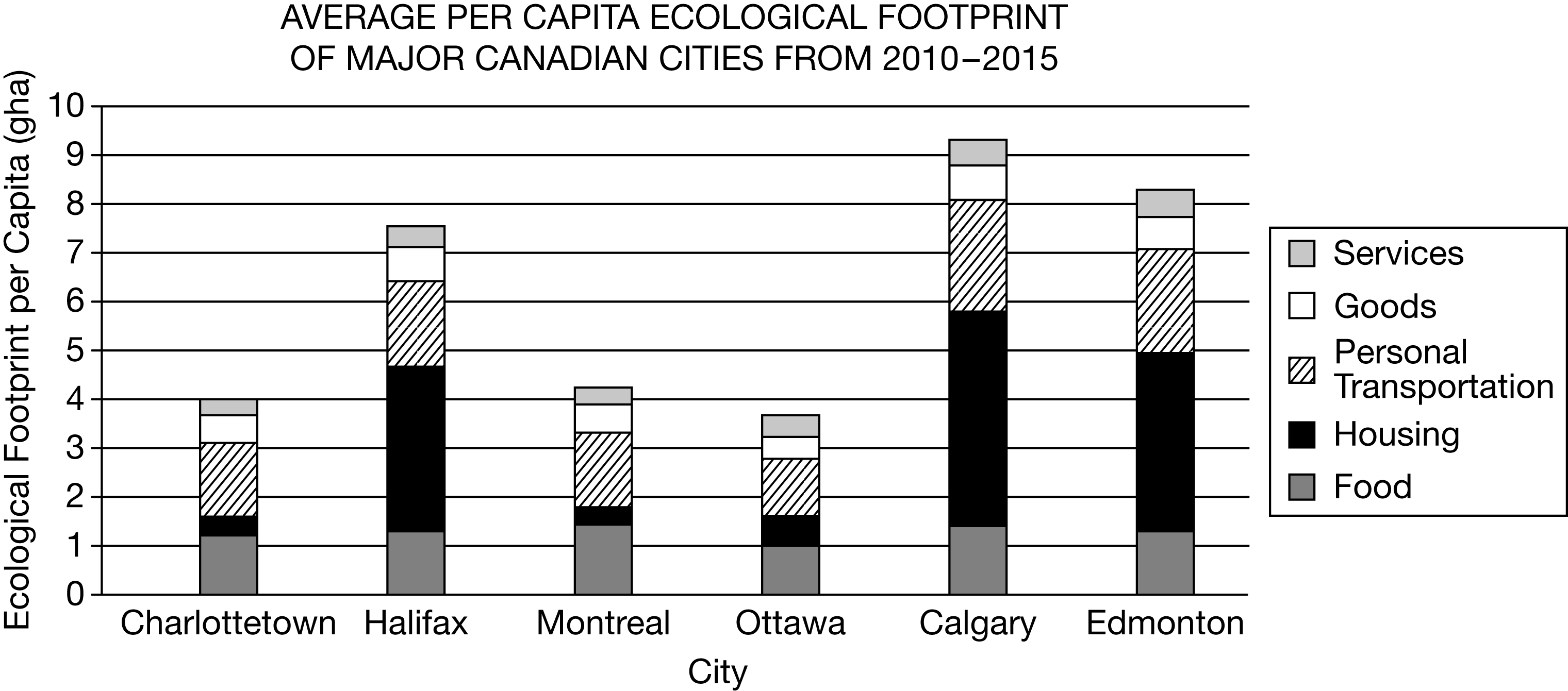 Based on the data, which of the following policies would most likely make the greatest reduction in the ecological footprint for all of the cities shown in the graph?
Based on the data, which of the following policies would most likely make the greatest reduction in the ecological footprint for all of the cities shown in the graph?
A) Setting higher fuel efficiency standards for vehicles
B) Increasing the cost to use public transportation
C) Offering tax incentives to individuals who recycle clothing and home goods
D) Subsidizing the cost of solar panel installation for homeowners
A) Setting higher fuel efficiency standards for vehicles
One solution for reducing the amount of atmospheric carbon dioxide would be to
A) increase oceanic temperatures to enhance carbon dioxide uptake
B) increase the rate of removal of tropical rain forests
C) decrease the total area of rice paddies
D) decrease the use of fossil fuels
E) decrease the production of chlorofluorocarbons
D) decrease the use of fossil fuels
Which of the following would most likely reduce the concentration of ground-level ozone in the air of a city?
A) Release of CFCs into the air of the city
B) Occurrence of several consecutive days of sunny weather
C) Formation of a temperature inversion
D) Decrease in the emissions of nitrogen oxides
E) Release of VOCs into the air of the city
D) Decrease in the emissions to nitrogen oxides
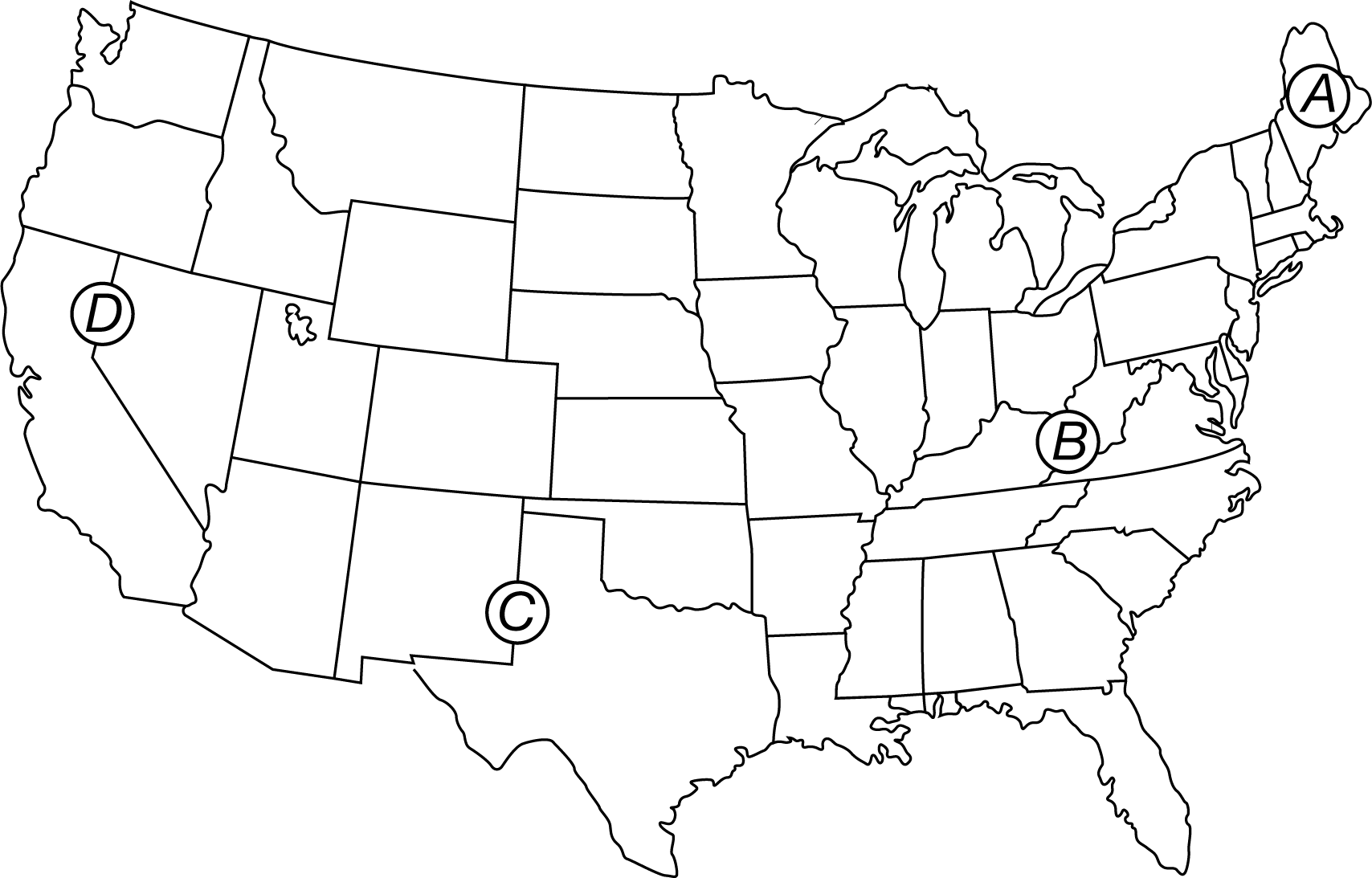 Which of the following areas shown on the map of the United States has a history of coal deposits and is most likely to have mining operations?
Which of the following areas shown on the map of the United States has a history of coal deposits and is most likely to have mining operations?
A) Point A
B) Point B
C) Point C
D) Point D
B) Point B
An advantage of using natural gas, rather than oil, as a fuel is that natural gas is
A) less of a contributor to global warming because it does not release CO2 when it burns
B) less expensive because most reserves are in the United States
C) more abundant because it is a by-product of photosynthesis
D) cleaner because it burns more completely
E) safer to store because it is a gas
D) cleaner because it burns more completely
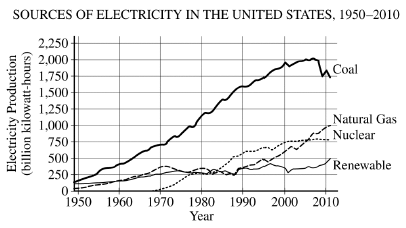 Which of the following is the most valid inference regarding electricity production, based on the graph above?
Which of the following is the most valid inference regarding electricity production, based on the graph above?
A) Electricity production from coal began to decrease in 2008 because of shortages in coal supplies.
B) Electricity production from coal began to decrease in 2008 because of the increasing use of natural gas and renewable energy.
C) The use of nuclear energy increased from 1970 to 2010 because of the low cost of constructing nuclear power plants.
D) The use of nuclear energy increased from 1970 to 2010 because of shortages in coal supplies.
E) Renewable energy has not increased as much as nuclear energy has since 1970 because of federal laws restricting construction of wind farms.
B) Electricity production from coal began to decrease in 2008 because of the increasing use of natural gas and renewable energy
Which of the following energy sources produces the most air pollutants when used during the generation of electricity?
A) Uranium
B) Photovoltaic cells
C) Fuel oil
D) Natural gas
C) Fuel oil
Which of the following describes an environmental problem that can result from the combustion of fossil fuels to generate electricity?
A) A chemical reaction occurs between the fossil fuel and oxygen to produce energy for the generation of electricity.
B) Carbon dioxide is a product of the combustion fossil fuels, and it can lead to global climate change when released into the atmosphere.
C) The combustion of fossil fuels can heat water to convert the water into steam to turn turbines that are connected to electrical generators.
D) Combustion reactions using fossil fuels require more energy than they produce and are therefore very inefficient.
B) Carbon dioxide is a product of the combustion fossil fuels, and it can lead to global climate change when released into the atmosphere.
Which of the following best describes an environmental problem associated with hydrologic fracturing, or fracking?
A) Fracking has led to an increase in the production of oil and natural gas, lowering energy prices.
B) Fractures in the shale will close up once the fracking fluid is removed unless fine particles, like sand, are introduced to hold them open.
C) The products of fracking release more carbon dioxide and sulfur compounds into the atmosphere than other fossil fuels.
D) Fracking fluids can escape from the drill hole and contaminate surface water and groundwater.
D) Fracking fluids can escape from the drill hole and contaminate surface water and groundwater.
A family of four lives in a three-bedroom house and uses an average of 900kwh of electricity per month. The family cools their house for three months during the summer with two window-unit air conditioners that each use of 350kwh electricity per month. Which of the following is the percentage of the family’s total annual electricity that is used to run the two air conditioners for the three summer months?
A) 9.7%
B) 19.4%
C) 38.8%
D) 17.8%
B) 19.4%
Which of the following is a way for the government to encourage efficient energy use?
A) Requiring higher fuel economy standards for new cars
B) Implementing government subsidies to keep gasoline prices low
C) Raising the speed limit from 55 to 70 miles per hour
D) Limiting the development of public transportation systems
E) Removing all taxes from gasoline at the fuel pump
A) Requiring higher fuel economy standards for new cars
Ground-level ozone in most major United States cities results primarily from
A) burning coal
B) burning fuel for cooking
C) producing electric power
D) industrial emissions
E) motor-vehicle exhaust
E) motor-vehicle exhaust
Which of the following has the largest proven coal reserves?
A) South America
B) The United States
C) Australia
D) Indonesia
E) Africa
B) The United States
Which of the following environmental problems is most often linked to the combustion of fossil fuels?
A) Cultural eutrophication in surface waters
B) Thermal inversions in mountainous coastal areas
C) Photochemical smog formation in the troposphere
D) Ozone thinning in the stratosphere
C) Photochemical smog formation in the troposphere
Of the following sources, which supplies the most commercial energy in the world today?
A) Solar
B) Oil
C) Biomass
D) Nuclear
E) Hydroelectric
B) Oil
In addition to volatile organic compounds (VOCs), which of the following components must be present in the atmosphere to create photochemical smog?
A) NOx and particulates
B) Particulates and UV light
C) NOx and UV light
D) UV light and CO2
C) NOx and UV light
Which of the following are direct products of the use of hydrocarbon fuels in automobile engines?
A) O, N, and CO
B) CO, Ar, and O3
C) CO2, H2O, and O3
D) CO2, O3, and Pb
E) CO2, NOx, and VOCs
E) CO2, NOx, and VOCs
There are various stages in the formation of coal as heat and pressure are increased and moisture content is decreased. These stages, in order, are
A) bituminous, peat, lignite, anthracite
B) peat, lignite, bituminous, anthracite
C) peat, lignite, anthracite, bituminous
D) lignite, bituminous, anthracite, peat
E) anthracite, bituminous, peat, lignite
B) peat, lignite, bituminous, anthracite
Which of the following best describes the process known as “mountaintop removal”?
A) The use of trees planted at high elevations to eliminate carbon dioxide from the atmosphere
B) The use of heavy equipment to move overburden downhill during the strip mining of coal
C) The placement of hazardous-waste disposal sites at high elevations in mountainous regions
D) The shearing away of undersea mountain peaks to improve shipping lanes
E) The reduction of glacial ice resulting from increased global temperatures
B) The use of heavy equipment to move overburden downhill during the strip mining of coal
The primary cause of acid precipitation in the northeastern United States is
A) the large number of automobile air conditioners leaking Freon
B) burning of sulfur-containing fossil fuels to produce electricity
C) deforestation, which reduces the number of trees removing atmospheric CO2
D) strip-mining, which releases large quantities of particulates into the atmosphere
E) global warming, which speeds the chemical reactions that produce acids
B) burning of sulfur-containing fossil fuels to produce electricity
Which of the following best describes the conditions under which peat is formed?
A) Partially decayed vegetation is placed under low-pressure, aerobic, acidic conditions.
B) Partially decayed vegetation is placed under high-pressure, anaerobic, alkaline conditions.
C) Partially decayed vegetation is placed under high-pressure, anaerobic, acidic conditions.
D) Partially decayed vegetation is placed under low-pressure, aerobic, alkaline conditions.
C) Partially decayed vegetation is placed under high-pressure, anaerobic, acidic conditions
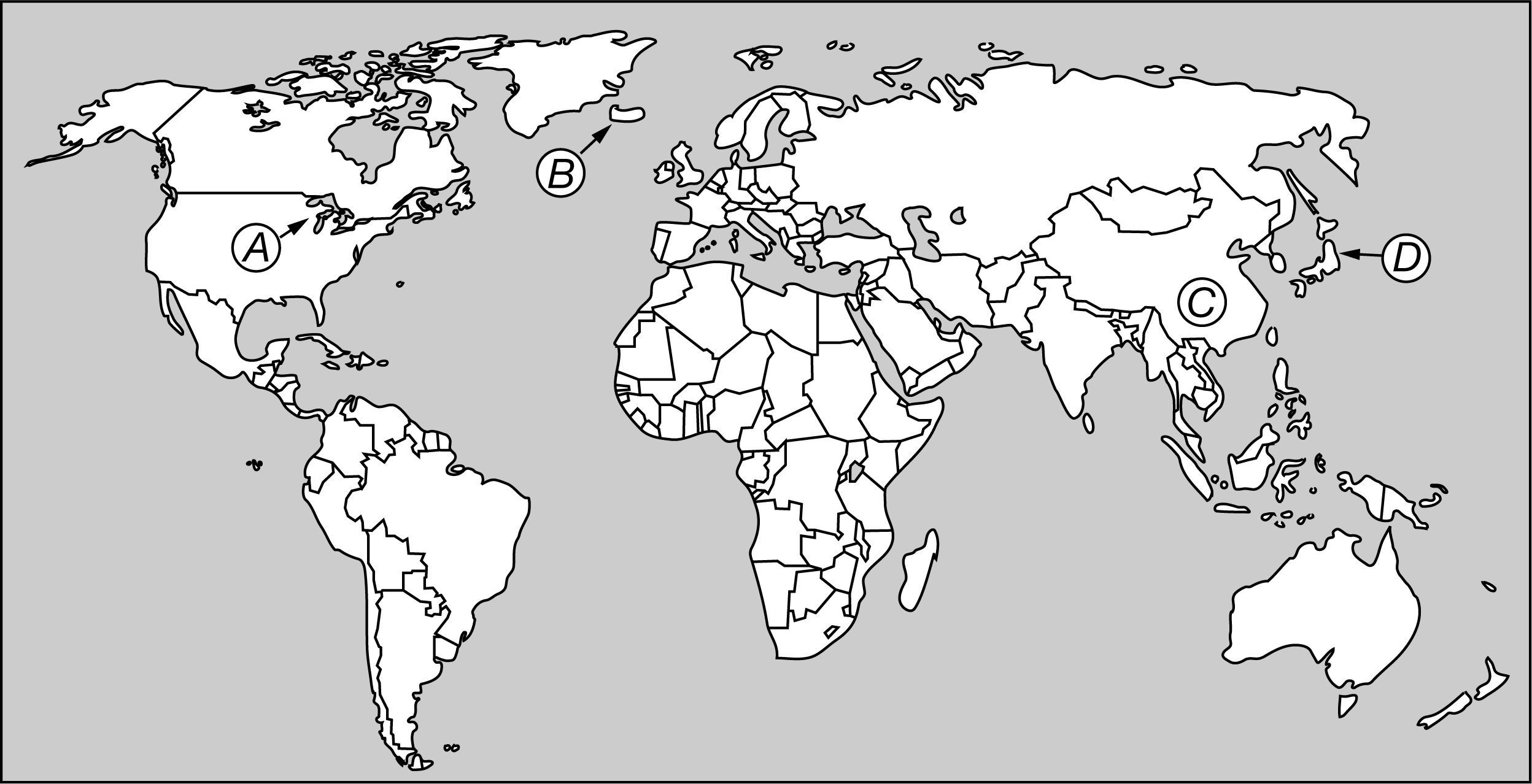 At this site a magnitude earthquake, which occurred at a nearby subduction zone, triggered one of the largest nuclear reactor disasters in history.
At this site a magnitude earthquake, which occurred at a nearby subduction zone, triggered one of the largest nuclear reactor disasters in history.
A) A
B) B
C) C
D) D
D) D
What is the ultimate source of energy for ecosystems?
Sunlight
What is Net Primary Productivity (NPP)?
The energy captured by primary producers minus the energy they expend.
What is Gross Primary Productivity?
Total energy captured by primary producers.
What is Energy Transfer - 10% Rule?
Only about 10% of energy is transferred between trophic levels.
What are Primary Producers?
Autotrophs (plants, algae) that produce organic compounds.
What are Primary Consumers?
Herbivores that consume primary producers.
What are Secondary Consumers?
Carnivores that eat herbivores.
What are Tertiary Consumers?
Predators at the third tropic level.
What are decomposers?
They break down dead organic matter
Why are Consumers beyond the tertiary level limited?
Due to insufficient energy transfer.
Describe the roll of the sun in ecosystems…
Photosynthesis transforms solar energy into chemical energy, sustaining life
What is the Hydrologic Cycle?
Movement of water through evaporation, condensation, precipitation, and more
Describe the steps in the carbon cycle…
1. Carbon enters the atmosphere as CO2
2. CO2 is absorbed by autotrophs such as green plants
3. Animals consume plants, thereby, incorporating carbon into their system
4. Animals and plants die, their bodies decompose and carbon is reabsorbed back into the atmosphere.
What is the increase in atmospheric carbon due to?
Human activities like burning fossil fuels.
Name the steps in the Nitrogen Cycle…
Nitrogen Fixation, Nitrification, Assimilation, Ammonification, Denitrification.
What is the largest reservoir of Nitrogen?
The Atmosphere
What is the Largest Reservoir of Carbon?
Sedimentary rocks and oceans
Nitrogen vs. Phosphorus Cycles
Nitrogen is primarily a gas, while phosphorus cycles through sediment
What are the Essential Nutrients for Plant Growth?
Nitrogen, Phosphorus, Potassium.
What is Nitrogen's Role in living organisms?
Constituent of proteins, nucleic acids, and more
What is Eutrophication?
Excessive nutrient input causing water body degradation.
What are some Abiotic factors?
temperature, precipitation, and light
What are som biotic factors?
plants, animals, and bacteria